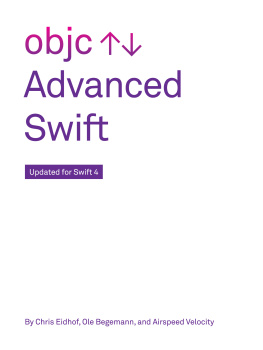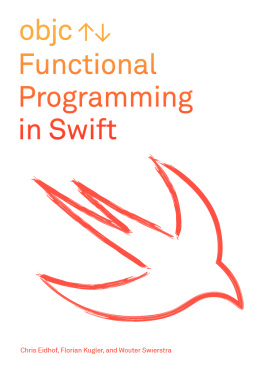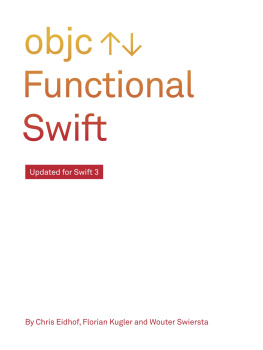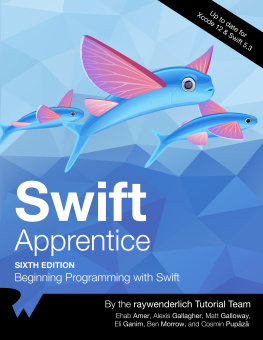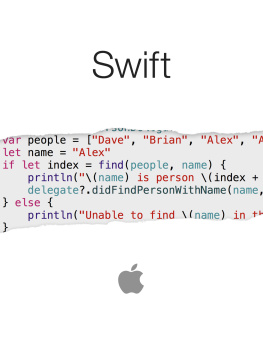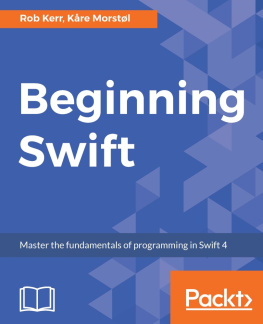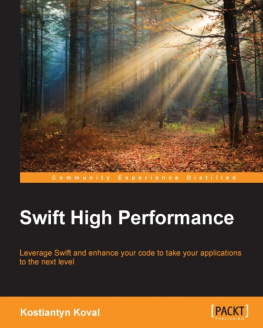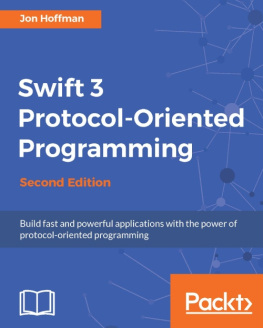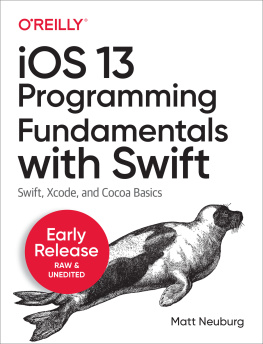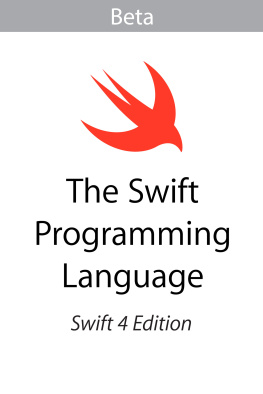Advanced Swift
Advanced Swift
Chris Eidhof
Ole Begemann
Airspeed Velocity
objc.io
2017 Kugler und Eidhof GbR
Introduction
Advanced Swift is quite a bold title for a book, so perhaps we should start with what we mean by it.
When we began writing the first edition of this book, Swift was barely a year old. We did so before the beta of 2.0 was released albeit tentatively, because we suspected the language would continue to evolve as it entered its second year. Few languages perhaps no other language have been adopted so rapidly by so many developers.
But that left people with unanswered questions. How do you write idiomatic Swift? Is there a correct way to do certain things? The standard library provided some clues, but even that has changed over time, dropping some conventions and adopting others. Over the past three years, Swift has evolved at a high pace, and it has become clearer what idiomatic Swift is.
To someone coming from another language, Swift can resemble everything you like about your language of choice. Low-level bit twiddling can look very similar to (and can be as performant as) C, but without many of the undefined behavior gotchas. The lightweight trailing closure syntax of map or filter will be familiar to Rubyists. Swift generics are similar to C++ templates, but with type constraints to ensure generic functions are correct at the time of definition rather than at the time of use. The flexibility of higher-order functions and operator overloading means you can write code thats similar in style to Haskell or F#. And the @objc and dynamic keywords allow you to use selectors and runtime dynamism in ways you would in Objective-C.
Given these resemblances, its tempting to adopt the idioms of other languages. Case in point: Objective-C example projects can almost be mechanically ported to Swift. The same is true for Java or C# design patterns. And monad tutorials appeared to be everyones favorite blog post topic in the first few months after Swifts introduction.
But then comes the frustration. Why cant we use protocol extensions with associated types like interfaces in Java? Why are arrays not covariant in the way we expect? Why cant we write functor? Sometimes the answer is because the part of Swift in question isnt yet implemented. But more often, its either because theres a different Swift-like way to do what you want to do, or because the Swift feature you thought was like the equivalent in some other language is not quite what you think.
Swift is a complex language most programming languages are. But it hides that complexity well. You can get up and running developing apps in Swift without needing to know about generics or overloading or the difference between static and dynamic dispatch. You may never need to call into a C library or write your own collection type, but after a while, we think youll find it necessary to know about these things either to improve your codes performance, to make it more elegant or expressive, or just to get certain things done.
Learning more about these features is what this book is about. We intend to answer many of the How do I do this? or Why does Swift behave like that? questions weve seen come up on various forums. Hopefully, once youve read our book, youll have gone from being aware of the basics of the language to knowing about many advanced features and having a much better understanding of how Swift works. Being familiar with the material presented is probably necessary, if not sufficient, for calling yourself an advanced Swift programmer.
Who Is This Book For?
This book targets experienced (though not necessarily expert) programmers such as existing Apple-platform developers, or those coming from other languages such as Java or C++ who want to bring their knowledge of Swift to the same level as that of Objective-C or some other language. Its also suitable for new programmers who started on Swift, have grown familiar with the basics, and are looking to take things to the next level.
The book isnt meant to be an introduction to Swift; it assumes youre familiar with the syntax and structure of the language. If you want some good, compact coverage of the basics of Swift, the best source is the official Apple Swift book (available on iBooks or on Apples website). If youre already a confident programmer, you could try reading our book and the Apple Swift book in parallel.
This is also not a book about programming for macOS or iOS devices. Of course, since Swift is currently mainly used on Apple platforms, weve tried to include examples of practical use, but we hope this book will be useful for non-Apple-platform programmers as well. The vast majority of the examples in the book should run unchanged on other operating systems. The ones that dont are either fundamentally tied to Apples platforms (because they use iOS frameworks or rely on the Objective-C runtime) or only require minimal changes, such as replacing the BSD-specific function we use to generate random numbers with a Linux equivalent.
Themes
Weve organized the book under the heading of basic concepts. There are in-depth chapters on some fundamental basic concepts like optionals or strings, and some deeper dives into topics like C interoperability. But throughout the book, hopefully a few themes regarding Swift emerge:
Swift is both a high- and low-level language. Swift allows you to write code similarly to Ruby and Python, with map and reduce, and to write your own higher-order functions easily. Swift also allows you to write fast code that compiles directly to native binaries with performance similar to code written in C.
Whats exciting to us, and whats possibly the aspect of Swift we most admire, is that youre able to do both these things at the same time. Mapping a closure expression over an array compiles to the same assembly code as looping over a contiguous block of memory does.
However, there are some things you need to know about to make the most of this feature. For example, it will benefit you to have a strong grasp on how structs and classes differ, or an understanding of the difference between dynamic and static method dispatch. Well cover topics such as these in more depth later on.
Swift is a multi-paradigm language. You can use it to write object-oriented code or pure functional code using immutable values, or you can write imperative C-like code using pointer arithmetic.
This is both a blessing and a curse. Its great, in that you have a lot of tools available to you, and you arent forced into writing code one way. But it also exposes you to the risk of writing Java or C or Objective-C in Swift.
Swift still has access to most of the capabilities of Objective-C, including message sending, runtime type identification, and key-value observation. But Swift introduces many capabilities not available in Objective-C.
Erik Meijer, a well-known programming language expert, tweeted the following in October 2015:
At this point, @SwiftLang is probably a better, and more valuable, vehicle for learning functional programming than Haskell.
Swift is a good introduction to a more functional style through its use of generics, protocols, value types, and closures. Its even possible to write operators that compose functions together. The early months of Swift brought many functional programming blog posts into the world. But since the release of Swift 2.0 and the introduction of protocol extensions, this trend has shifted.

